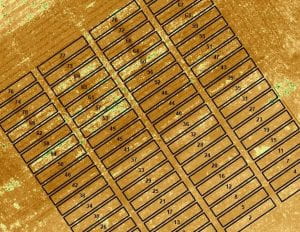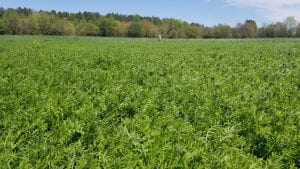Jamie Taraila, Jarrod Miller, and Amy Shober
With April and warmer temperatures finally here, it is time to think about cover crop termination. This spring, we expect lower cover crop biomass at burndown due to the cool, wet winter conditions that delayed growth, particularly small grains. Therefore, termination timing decisions are very important this year. We must recognize that there are pros and cons of early and late cover crop termination and make decisions that maximize benefits.
Early termination is typically the easiest option. With early termination, growers benefit from the lower C:N ratio of small grains and even the legumes. Generally, termination of a cover crop with a C:N ratio less than 25 means the cover crop can supply N to the soil to feed the spring crop. Results of our 2018 USDA-NRCS supported field trials showed that delaying termination by two weeks resulted in an increase in the C:N ratio of a rye cover crop from 23:1 to 33:1.

Figure 2: Cover crop trials planted green. Checking planter settings kept these plots from having reduced stands.
If terminated when the C:N ratio is higher than 25:1, there is a possibility that soil microbes can can tie up (immobilize) N as microbes work to break down high C:N ratio residues. This can reduce N availability in early spring when cash crops are being planted. It is also more difficult to plant into heavy cover crop biomass that results from delaying termination. When planting green into standing cover crops(Figure 2) we have observed a reduction of up to 10,000 plants/acre for corn when planter settings were not corrected. It is important to get out and check seed placement and depth during planting when planting green. This will allow you to make any necessary adjustments to the planter to ensure good seed to soil contact, improving emergence and reducing stand variability.
Despite potential planting and nutrient management challenges related to later termination, farmers who terminate cover crops later often see a reduction in weed pressure. In 2020 NRCS supported UD field trials, weed pressure was significantly reduced in plots with a cover crop when compared with the no-cover crop plots, regardless of termination timing (Figure 3). Greater cover crop biomass is known to reduce weed competition for grain crops which can be achieved by delating termination.
Ultimately, the final decision on when to terminate cover crop simply be related to springtime weather variability and finding a time when conditional allow you to get into the field and spray.

Figure 3 : Plots with yellow and green are showing more weed growth post corn harvest when no cover crops were used.

